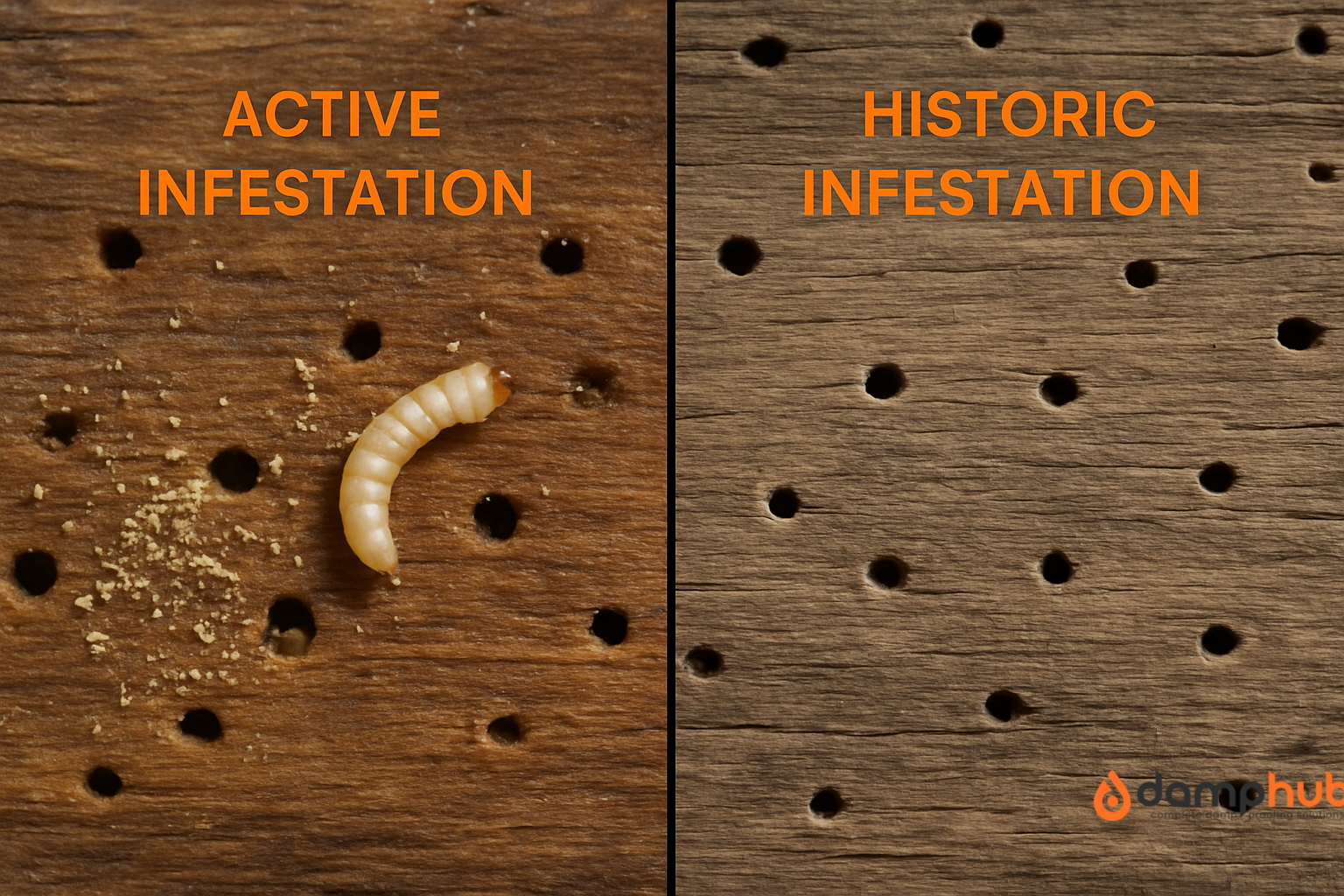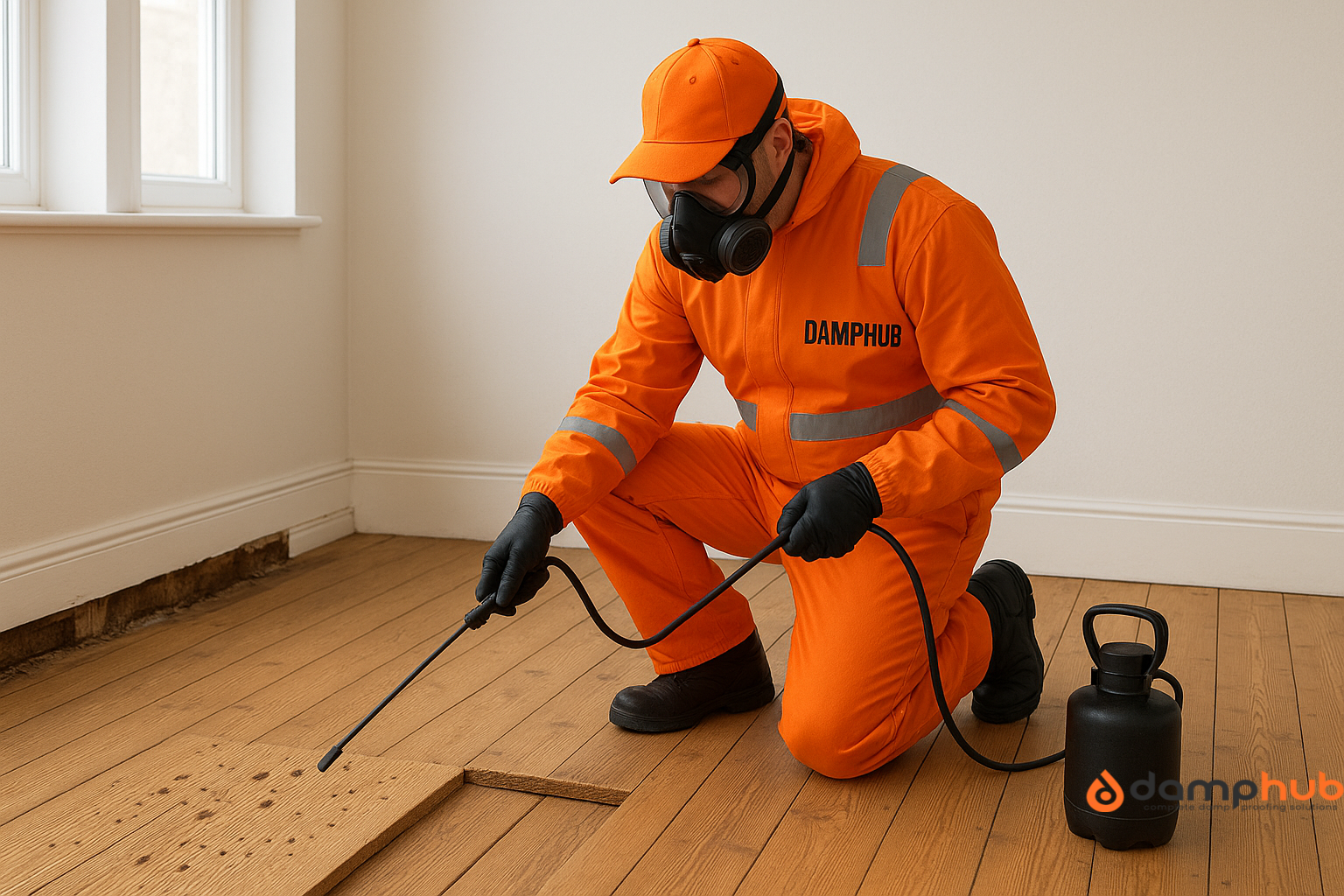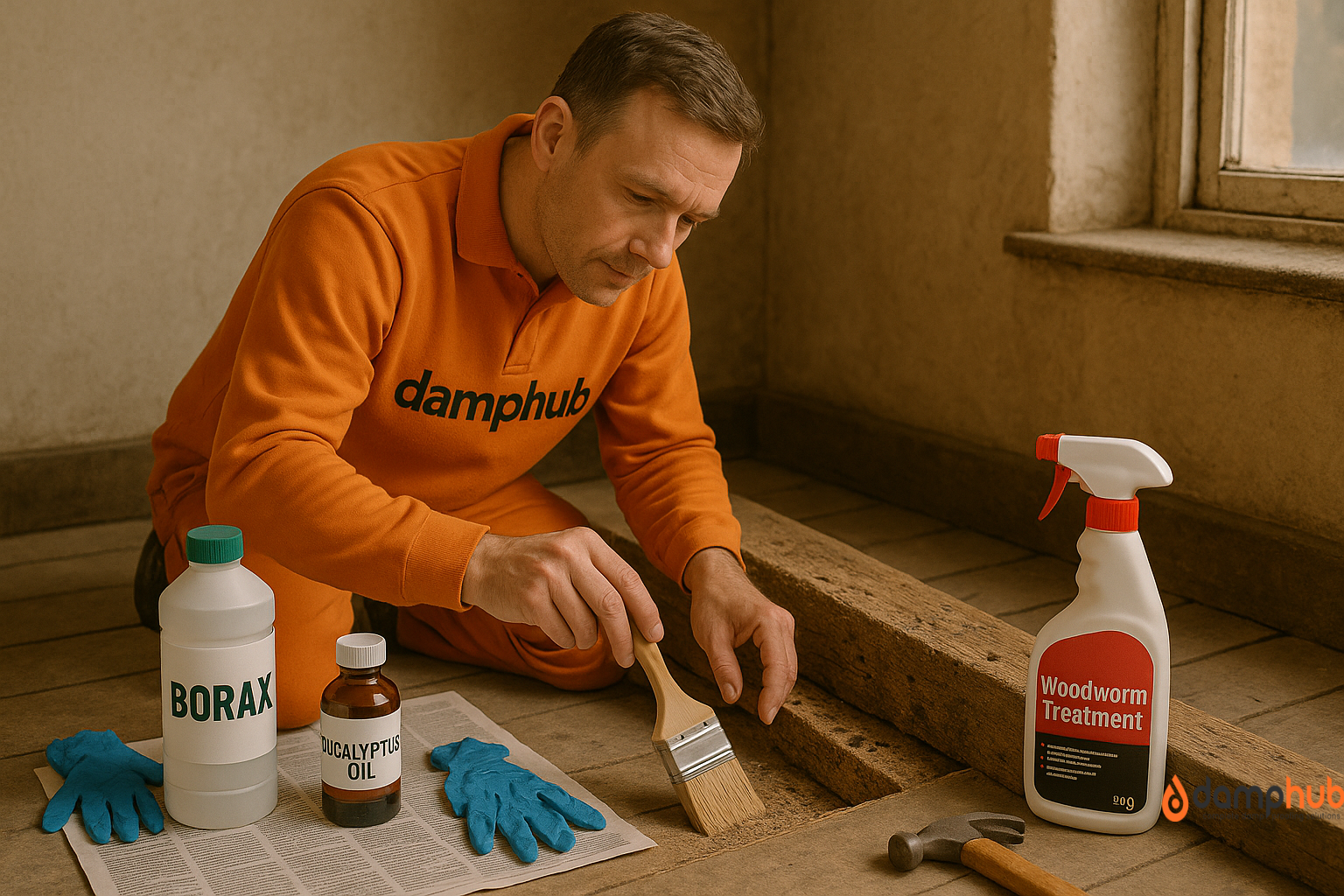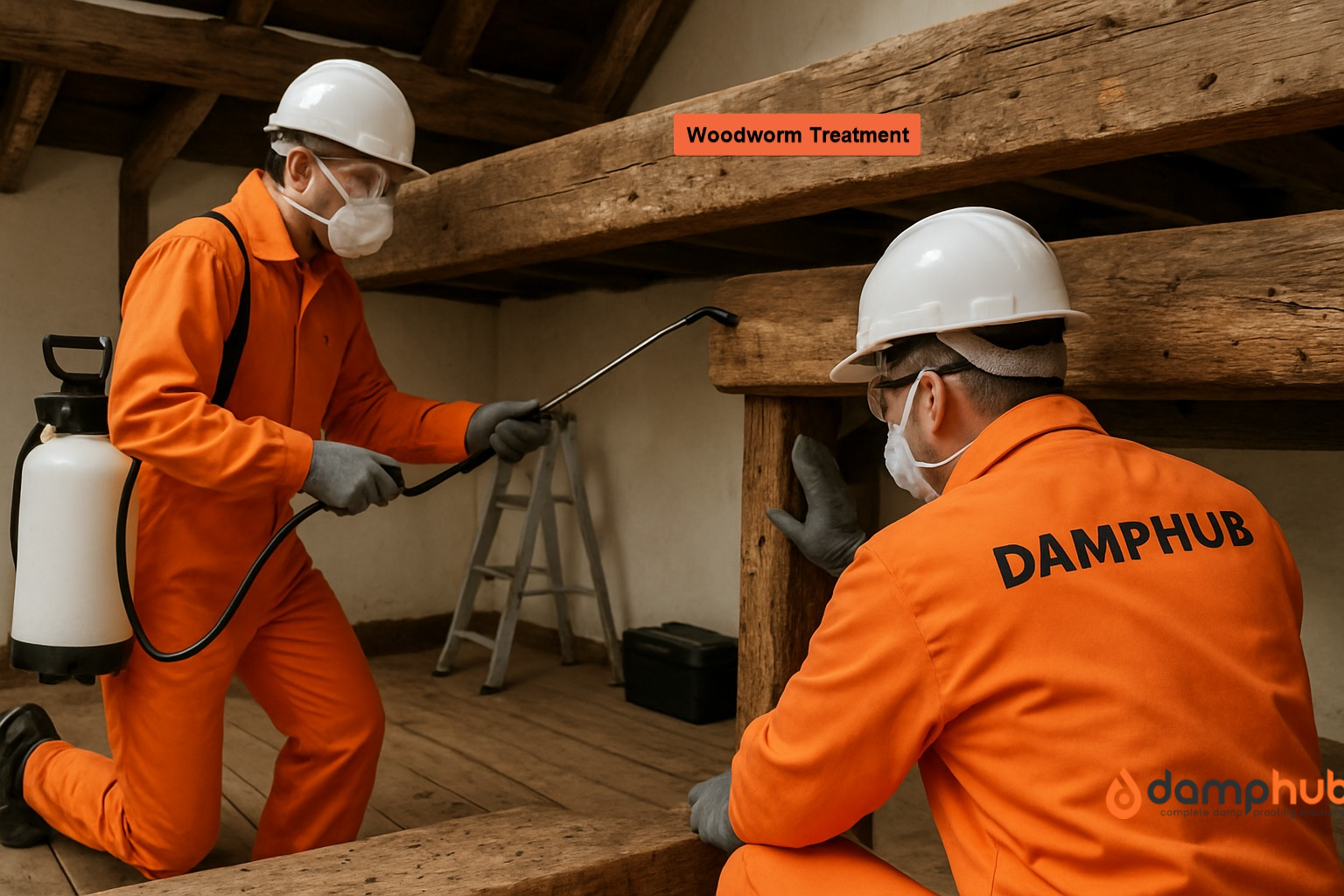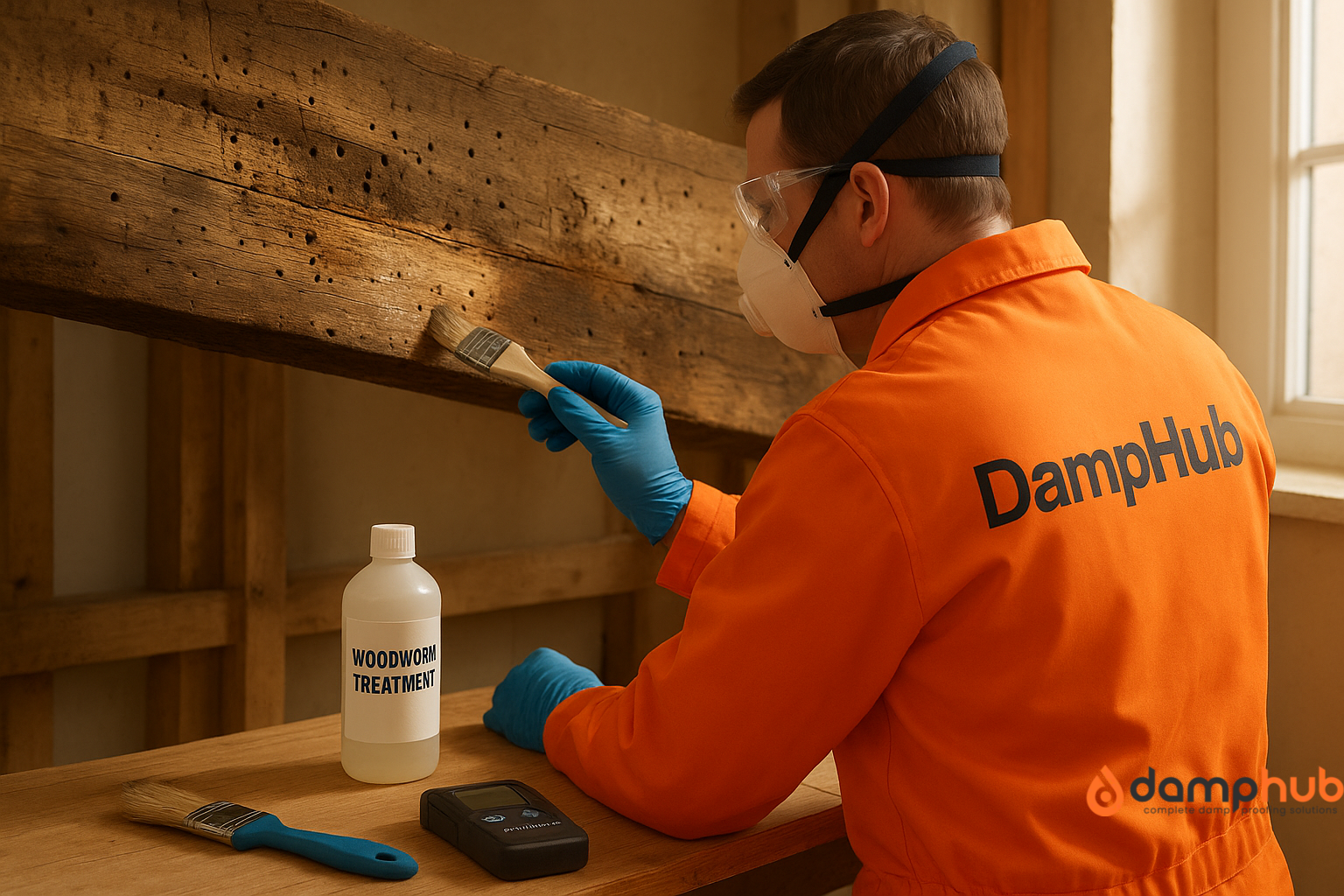
Woodworm treatment is just the stuff you use to boot out those tiny bugs munching away inside your wooden furniture, floorboards, or beams.
Woodworm itself isn’t one single bug — it’s the name for the larvae of a bunch of different wood-boring beetles. They burrow through wood, leaving those classic little holes and sometimes dusty piles of their droppings (called frass).
If you leave it alone, these little critters can quietly wreck your wood over time. They’re like termites’ shy cousins — chewing away silently for years until the wood gets weak.
So, woodworm treatment is the magic potion that kills the larvae and stops new beetles from laying eggs. Think of it as a shield and bug spray all in one.
How Does Woodworm Treatment Work?
Picture the beetle larvae as uninvited guests having a wild party inside your wood. The treatment is the bouncer who shows up, kicks them out, and locks the doors so they don’t sneak back in.
Most treatments soak into the wood, going deep where the larvae hide. They have chemicals that kill bugs but are usually safe for people if used correctly. Some kill larvae instantly, others set up a barrier to stop fresh beetles from moving in.
The secret sauce? Getting deep. The woodworm treatment must penetrate well — simply coating the surface won’t suffice. That’s why you can’t just slap it on and call it done.
How do I know if Woodworm Treatment is Needed?
Sometimes spotting woodworm is tricky, but here are the red flags:
- Little piles of powdery dust (frass) underneath
- Wood feels soft or crumbly when you poke it
- Cracks or splits showing up over time
- Clusters of holes near damp or poorly ventilated areas
- Tiny round holes in wood (about 1-2 mm wide)
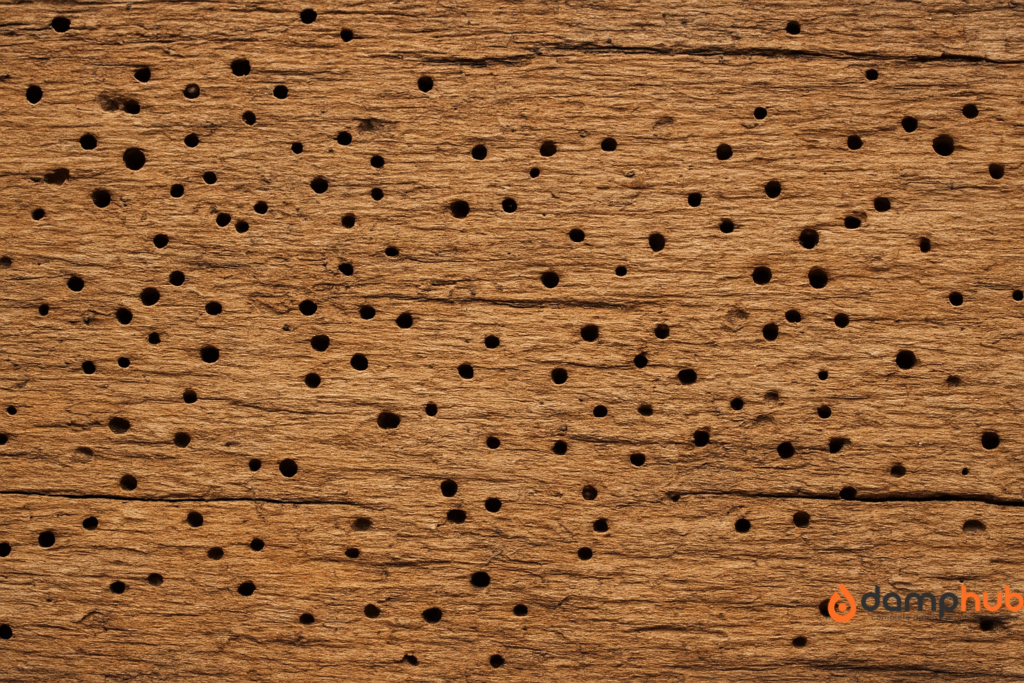
Heads-up, though — not every hole means active woodworm infestation. Some might be old and harmless. To check if it’s live, look for fresh frass or catch a tiny beetle buzzing around in warmer months (usually May to September).
If you’re scratching your head, a professional surveyor can give you a proper answer.
What Types of Woodworm Treatment are Available?
There’s a handful of treatments out there — no one-size-fits-all here.
- Liquid Treatments: The DIY fave. You brush, roll, or spray liquid onto the wood. It soaks in and kills larvae on contact. Sometimes you’ll need a few coats.
- Fumigation: The big guns for serious infestations. The wood gets sealed in a tent, then gas kills the pests. Not something to try yourself — call in the pros.
- Boron-Based Treatments: Boron’s a natural mineral tough on bugs but gentle on wood and people. Perfect if you want something less harsh, especially for antiques.
- Injected Treatments: For stubborn spots or thick timber, some treatments get injected directly inside. Works well, but fiddly.
Picking the right one depends on your situation.
Types of Woodworm Treatment
Liquid Treatments
Brush, roll, or spray liquid onto wood. Soaks in to kill larvae. May need multiple coats.
Fumigation
Professional-only. Wood is sealed and gassed for severe infestations.
Boron-Based
Natural mineral, tough on pests but safe for wood and people. Great for antiques.
Injected
For thick or stubborn timber, treatment is injected directly inside.
How Do I Prepare Wood Before Applying Treatment?
No shortcuts here — prepping is everything.
- Clean it up. Dust, dirt, loose bits? Brush or vacuum them off.
- Strip or sand old paint or varnish that might block the treatment from soaking in.
- Make sure the wood’s dry. Damp wood is a no-go, and moisture invites new bugs. Fix leaks or improve airflow first if needed.
- Scrape or sand away crumbly or loose wood so the treatment can reach solid timber.
- Clear away any fresh frass or sawdust so you can keep an eye on new activity.
- Ventilate your workspace well — open windows, use fans. These chemicals can stink and aren’t great to breathe in.
How to Apply Woodworm Treatment?
Here’s the hands-on part. You’ve got a few options:
- Brushing: A solid paintbrush will do. Cover all sides evenly, especially edges and ends where larvae hide. Don’t forget to get some inside holes.
- Spraying: Got a spray bottle or garden sprayer? Great for bigger surfaces. Spray lightly and evenly, outside or in a well-ventilated spot.
- Soaking: For smaller wood pieces or furniture with woodworm, dunking in a treatment bath works well. Follow the instructions for how long to soak.
Adult Beetles vs Larvae — Key Differences
| Feature | Adult Beetles | Larvae |
|---|---|---|
| Shape | Oval, dome-like | Long and tapered (carrot-shaped) |
| Colour | Solid black or very dark brown | Brown and fuzzy |
| Size | Small — about the size of a sesame seed | Larger than adults — up to 8 mm |
| Where Found | Near windows, often trying to get out | Hidden areas — under furniture, in carpets |
| Behaviour | Mostly harmless — feed on pollen | Destructive — feed on natural fibres |
| Signs | Live beetles near light | Moulted skins and fabric damage |
You may also want to read our other related cost: Woodworm Treatment Costs Explained: Prices, Factors And How to Save
Pro Tip
Don’t drown the wood. More isn’t better here. Follow the instructions and be patient — sometimes you need a second coat a week later.
How Long Does it Take for Woodworm Treatment to Dry?
Surface drying usually takes a few hours, but the real deal is how long it takes to soak deep inside the wood. That can be anywhere from a day to a few days, especially with thick timber.
Until then, don’t rush to varnish or paint until it’s 100% dry — otherwise, you might trap moisture and mess up the treatment.
💡Pro Tip
Keep fresh air moving to speed things up and help clear out chemical smells.
Good to Know
Even after treatment, keep the furniture in a dry, airy space. Damp corners and poor airflow make the perfect nursery for the next wave of beetles.
How Often Should Woodworm Treatment be Reapplied?
One solid treatment often does the job. But if the infestation was heavy or the wood is damp, a follow-up can be smart.
Check your wood after about a year. If fresh holes or frass show up, treat again. Some people also do preventative treatments every few years, especially in older or damper places.
Keep in mind: paint or varnish on top can seal in chemicals and reduce their effect over time.
Can I Apply Woodworm Treatment Myself, or Should I Hire a Professional?
If it’s just a small chair or a few boards, and you know how to apply woodworm treatment, you can comfortably consider DIY woodworm treatmet. Most treatments come with clear steps, and tools aren’t complicated. Plus, it feels great to save your own stuff.
But if you’re tackling floorboards, structural timber, or a big infestation, a pro is worth it. They have stronger treatments, know tricky spots, and can spot hidden problems.
Also, if you live in an older or listed property, they’ll handle it right without wrecking the character.
No shame in asking for help — sometimes it’s just easier and safer.
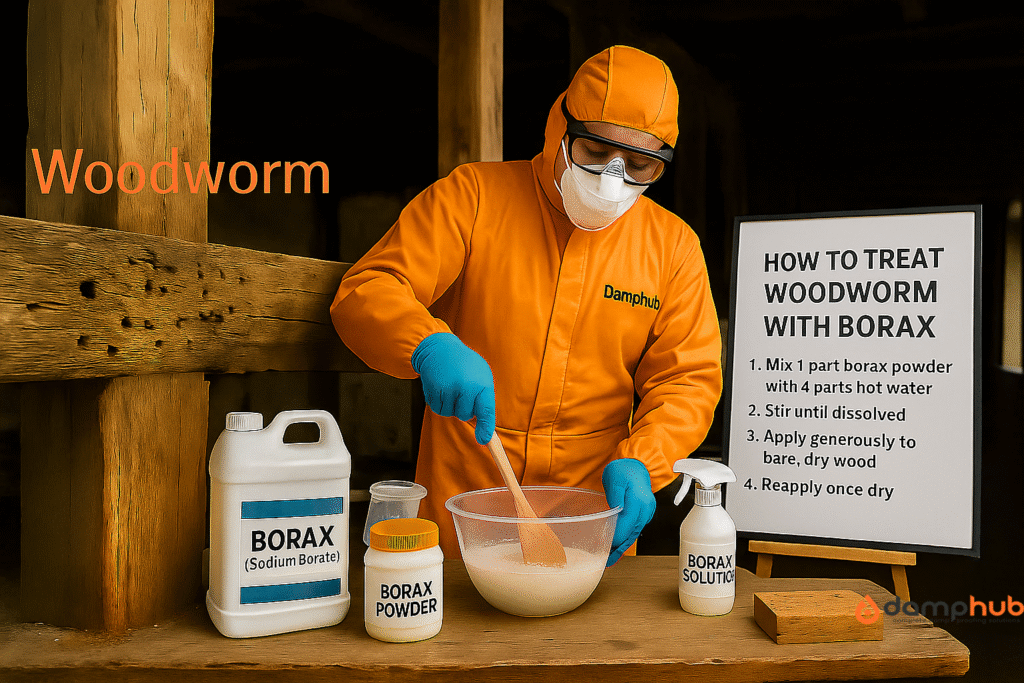
What Safety Measures Should I Take When Using Woodworm Treatment?
This stuff isn’t water — even the gentler ones can irritate if you’re careless.
- Always read the label.
- Wear gloves, goggles, and a mask.
- Work in a well-ventilated space.
- Avoid spraying near kids or pets.
- Keep treatments away from children and animals.
- Wash off your skin quickly if it gets on you.
- Don’t smoke or use open flames nearby — some treatments catch fire easily.
Treat the chemicals with respect and you’ll be fine.
How Do I Repair Wood After Treatment?
- Once the treatment’s dry, you might want to fix those holes and damage.
- For painted wood, use wood filler or putty in a matching color. Press it in, let it dry, then sand smooth.
- For bare or varnished wood, wax sticks or wood fillers work well.
- Big cracks or chunks missing? You might need to patch or replace sections.
- After filling, repaint or varnish to protect and finish things off.
If the wood’s too soft or rotten, filling won’t fix structural problems — call a carpenter.
Can Woodworm Come Back After Treatment?
Sure, it can. Woodworm isn’t always gone for good after one round.
If moisture or poor airflow sticks around, new beetles can move in and lay eggs.
Some treatments don’t reach every larva deep inside thick wood.
That’s why keeping things dry, aired, and checked regularly matters.
If you spot new holes, don’t panic. Treat it again quickly before it gets worse.
How Can I Prevent Woodworm from Returning?
Prevention is your best friend.
- Keep your home dry and well-ventilated. Fix leaks and damp spots.
- Use a dehumidifier in damp basements or cellars.
- Store firewood off the ground and away from your house.
- Check new or reclaimed wood before bringing it inside.
- Don’t block airflow by piling stuff against wooden walls or floors.
- Treat vulnerable wood every few years with a boron-based preventative.
- Regularly inspect your timber for new holes or dust.
Happy, dry wood is way less attractive to woodworm.
That’s it. Woodworm might be sneaky, but it’s no match if you keep on top of it with the right treatment and a bit of care. Your wood — and your home — will thank you for it.
How to Apply Woodworm Treatment: Questions Asked

-
Will woodworm treatment change how my wood looks?
Sometimes, yes. Lighter woods can darken a touch, and you might notice a faint patch where the liquid soaked in more. If you’re nervous about it, try a small, hidden area first before committing to the whole thing.
-
Is there a best time of year to apply woodworm treatment?
You can treat wood any time, but summer has one perk — it’s easier to spot fresh activity because beetles are more active. Also, warmer weather means the wood is usually drier, so the treatment soaks in better.
-
Can I put woodworm treatment straight over painted or varnished wood?
Not really. If there’s a finish on it, the treatment just sits on top. You’ll want to strip or sand the surface first so it can get into the timber where the larvae are.
-
Do I need to clear out while woodworm treatment is being done?
For small furniture jobs, no. Just keep pets and kids out and open the windows. If you’re doing a whole room or using a strong solvent-based product, you might want to crash somewhere else until the smell clears.
-
What if I miss one little area?
That’s risky. Woodworm can tunnel around inside timber, so leaving even a small patch untreated is like giving them a safe bunker. Always treat the entire piece or section, not just the holes you see.
-
Could they move into other wood after I start treatment?
Yes — adult beetles can fly. If you’ve got untreated wood nearby, they might hop over before the chemicals kick in. If you can, move untreated stuff out of the area until you’re done.
-
Will woodworm treatment protect against other pests too?
Some products will, especially those with boron. But it’s not a one-size-fits-all pest fix. If you’ve also got termites or other wood-borers, you might need a separate treatment.

